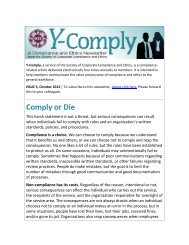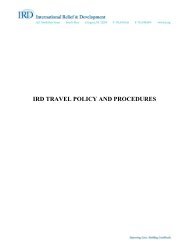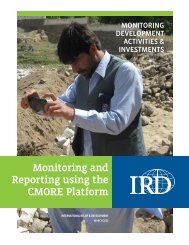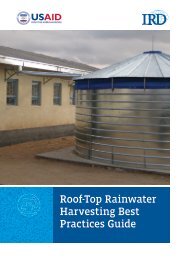IRD Vehicle Policy - International Relief & Development
IRD Vehicle Policy - International Relief & Development
IRD Vehicle Policy - International Relief & Development
Create successful ePaper yourself
Turn your PDF publications into a flip-book with our unique Google optimized e-Paper software.
Title: <strong>Vehicle</strong> <strong>Policy</strong> Effective Date: 11/22/10<br />
licensed taxicabs. Frequently, local transportation, such as buses, may not be safe. Consult with<br />
HQ or local security officer before taking local transportation.<br />
2. Hire one or more drivers who provide their own autos to accommodate the travel needs of<br />
staff both within the project city and for longer-distance project trips. This may be the preferred<br />
option when it is difficult to purchase a U.S.-manufactured car in country or to bring one in. It is<br />
critical that project management monitor maintenance and service of the vehicles. In general,<br />
funds for maintenance and service are paid to the driver via the U.S. government-approved<br />
mileage rate, as translated into local currency. You may want to set up differential rates for<br />
intra-city vs. inter-city trips. <strong>Vehicle</strong> logs must be maintained so that travel documentation is<br />
available for support of billing and expenses and (where pre-approved by USAID) for personal<br />
use reconciliation for reimbursement back to the project. Cars and drivers should be in<br />
compliance with local laws related to vehicles such as insurance, registration, and/or licensing.<br />
Verify compliance by asking to see the documentation. Where possible, attempt to hire vehicles<br />
from rental agencies so that insurance issues are covered and an acceptable level of vehicle<br />
safety equipment is present. It should also be noted that some missions require the use of U.S.<br />
origin vehicles.<br />
3. Purchase one or more project cars for project travel. There are restrictions on the purchase<br />
of automobiles (see ADS 312.5.3) and USAID approval is required prior to purchase. Any cars<br />
that are purchased must be of U.S. origin unless a waiver from USAID is obtained prior to<br />
purchase. You should follow <strong>IRD</strong>’s procurement procedures. <strong>IRD</strong>’s Contracts and Grants<br />
office must be involved in any car purchase. (See form: <strong>Vehicle</strong> Rental Contract)<br />
As with many other issues, look to your client and other contractors for guidance concerning which<br />
option you choose.<br />
The remainder of this section pertains to situations in which there are project cars (either driver-supplied<br />
or purchased by the project).<br />
Driver Compensation. Driver contracts are generally for 40 hours per week. You may elect to stagger<br />
the work hours of drivers to allow transportation coverage before and after the standard office workday.<br />
Like other staff members, drivers are paid from the time they reach the office in the morning until they<br />
finish their last assignment at night. They are not compensated for the time required to drive to and from<br />
their home to the office each day unless the driver must provide transportation to and/or from the airport<br />
late at night or early in the morning. The project requires that all full-time drivers hold a valid driver’s<br />
license.<br />
Scheduling Ground Transportation. Each site determines its own system for managing the efficient<br />
scheduling and allocation of drivers to meet requests for local transportation. To the extent possible,<br />
trips should be planned and coordinated to ensure efficient use of vehicles.<br />
The project should name an individual who is responsible for scheduling vehicle use. This person is<br />
responsible for setting up systems to allow staff to request transportation and for administering those<br />
systems. The person who manages transportation is responsible for solving problems and seeking ways<br />
to accommodate everyone’s needs reasonably. (See all applicable forms)<br />
Driving Overview<br />
Safety is our first concern. The driver and his or her supervisor are responsible for the condition of the<br />
vehicle, and is expected to drive according to country-specific traffic regulations, road and weather<br />
Notice: A printed copy of this document may not be the latest version.<br />
Available online: https://portal.ird.org<br />
Updated: April 2012 4


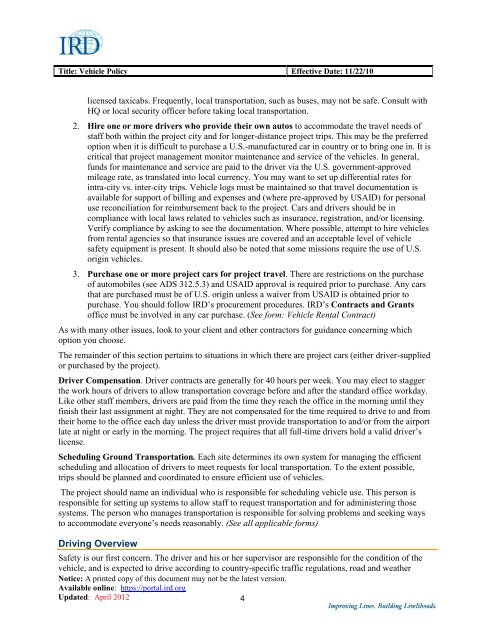
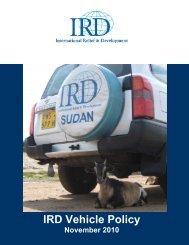
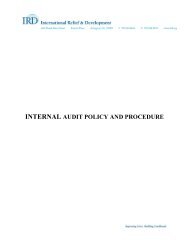
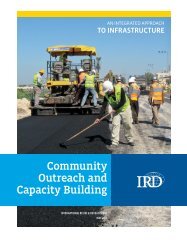
![Guide bonne pratique production d'oignon qualité_VF_4_2411012[1]](https://img.yumpu.com/23506639/1/184x260/guide-bonne-pratique-production-doignon-qualitac-vf-4-24110121.jpg?quality=85)

